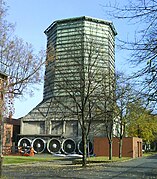Tormented bearer
| Peiner Träger GmbH
|
|
|---|---|
| legal form | GmbH |
| founding | 1858 |
| Seat |
Peine , Germany |
| management | Roger Schlim , Chairman of the Management Board |
| Number of employees | approx. 770 (2015) |
| Branch | steel |
| Website | www.peiner-traeger.de |
The Peiner carrier GmbH is a German steel plant in Peine and belongs to the Salzgitter group.
The Peiner Stahlwerk produces around one million tons of steel annually, which is processed into small and large-format beams in the heavy beam line and the universal medium beam line , which are sold for a wide variety of construction projects all over the world. The number of employees was around 1200 in 2012.
Tormented bearer
It is named after the “Peinerträger”, known worldwide in specialist circles. It is a parallel- flanged wide-flange beam that was developed and patented by the company in 1914.
history

The Ilseder Hütte stock corporation , based in Peine , then part of the Kingdom of Hanover , was founded in 1858 by Gerhard Lucas Meyer . The decisive factor here were the iron ore deposits found in Bülten , Lengede and Dörnten in northern Harz . Pig iron was to be extracted from them in the newly built Ilsede blast furnace . Landowners and merchants in the area subscribed to the majority of the shares. In 1880, the Peiner Walzwerk stock corporation, founded in 1872, was acquired in Peine. There the Thomas steelworks , known in Peine for its "brown cloud", and in 1900 the Siemens-Martin furnace were completed there in order to supply the rolling mills, which were gradually expanded, with input material. They produced heavy girders, including the wide flange girders patented in 1914. In order to ensure the supply of coal for smelting the pig iron, hard coal mines were acquired in Herne and Minden in 1921 .
During the Second World War, there were seldom attacks on the plant facilities. The largest failures were due to the lack of trained staff and the inadequate supply of coal, gas and electricity. At times blanks were produced for the manufacture of anti-aircraft guns. On April 10, 1945, Peine surrendered to the advancing troops of the US Army, thus saving both the city and the plant from being destroyed by further acts of war.
In the 1960s, around 5,000 steelworkers were still employed in the facilities. In the years 1961/1962 the steelworks was modernized and extended by the three towers of the converters of the newly built steelworks, which were visible from afar until the 1990s. In 1964 the Thomas steel mill was shut down. This was followed in 1970 by the merger with Salzgitter Hüttenwerk AG through the inclusion of the steelworks in Salzgitter - including the blast furnace, steelworks and sheet metal rolling mills - in Ilseder Hütte in return for shares. Salzgitter Hüttenwerk AG, a subsidiary of the state-owned Salzgitter AG at the time , had acquired the metallurgical plant in 1953 from Reichswerke AG for ore mining and ironworks. The newly formed group was then renamed Stahlwerke Peine-Salzgitter. In 1975 the newly built universal carrier line was put into operation. Due to the more modern and larger facilities, pig iron production was relocated from Ilsede to Salzgitter in 1983. After 123 years of operation and 51 million tons of pig iron produced, the blast furnaces in Ilsede were shut down. The coking plant, the power station and the ancillary facilities remained in operation for the production of coke for the Salzgitteraner blast furnaces until September 1995. In 1989, Preussag Stahl AG bought the state-owned shares in the steelworks and renamed it to Preussag AG in 1992. Since the Peine steelworks was now in the middle of the city center due to the ever-growing Peine, the environmental protection regulations were also tightened. As a further operation was not possible for these reasons as well as for financial and logistical reasons (coke from Ilsede was transported to Salzgitter to melt pig iron for Peine there), the electric furnace was put into operation in 1996. This made the steelworks and the coking plant superfluous and shut down.
In 1998 Preussag Stahl AG sold its shares to the State of Lower Saxony and the Norddeutsche Landesbank . This prevented a takeover by the Luxembourg steel group Arbed (now Arcelor Mittal ). After a restructuring of the group in 2001 into independent companies (Peiner Träger-, Salzgitter Flachstahl- and Ilsenburger Grobblech GmbH, and also Mannesmann- Röhren and Hoesch -pundwall) under the leadership of Salzgitter AG, the construction of a second continuous casting plant and the modernization the power supply of the Peine plant, which is now up to 40 years old, has been approved and implemented. After the extensive modernization, nothing is left of the former rolling mills and furnaces.
In 2006, the parent company Salzgitter AG decided to initiate an investment program called Project 2010 for the Peine plant . This concept includes the construction of a second electric furnace and the modernization of the Universal Mittelstrasse.
Individual evidence
- ↑ Reconstruction and cuts to counter the steel crisis. In: focus online. September 26, 2013, accessed September 29, 2015 .
Web links
Coordinates: 52 ° 18 ′ 56.9 ″ N , 10 ° 14 ′ 26.9 ″ E




